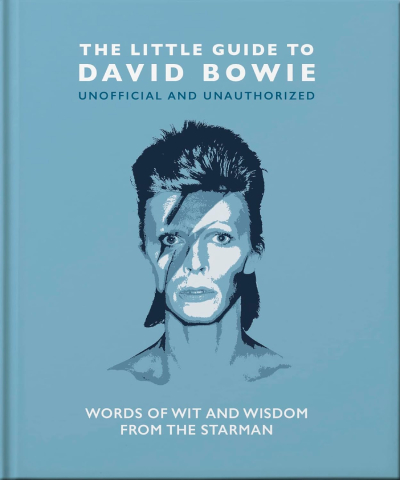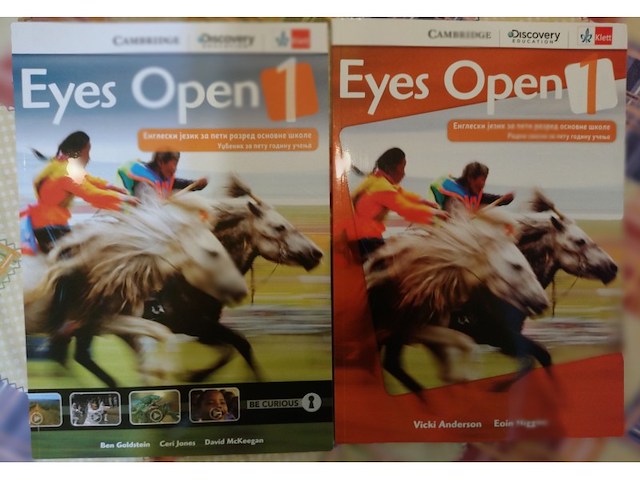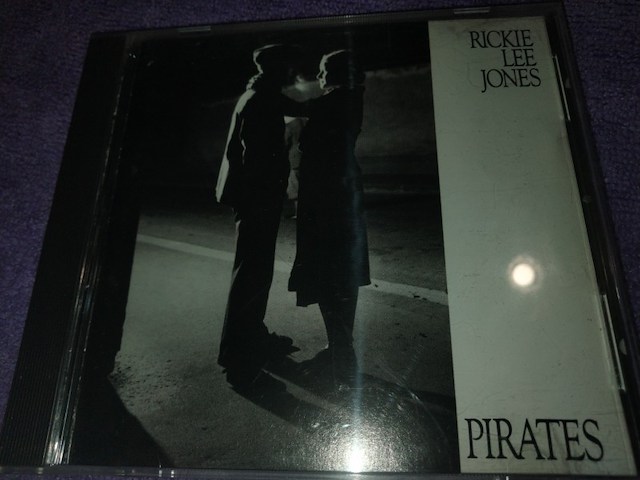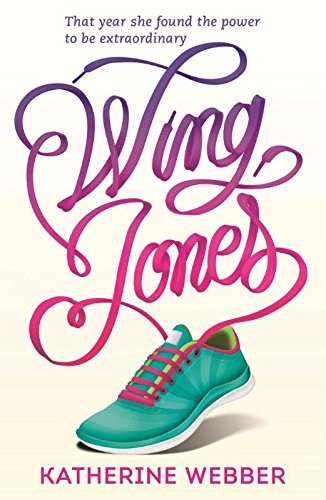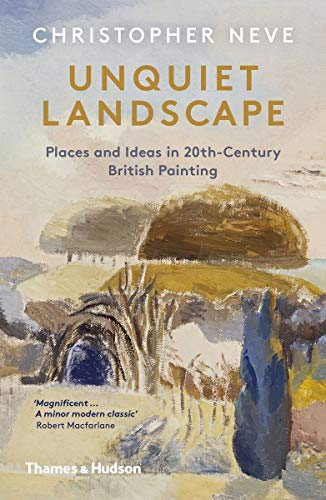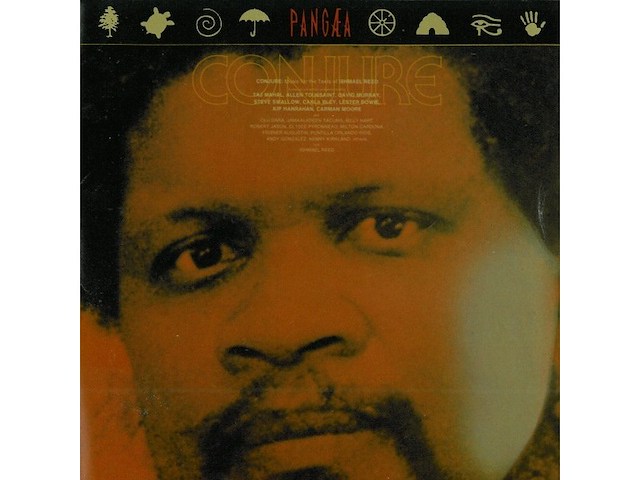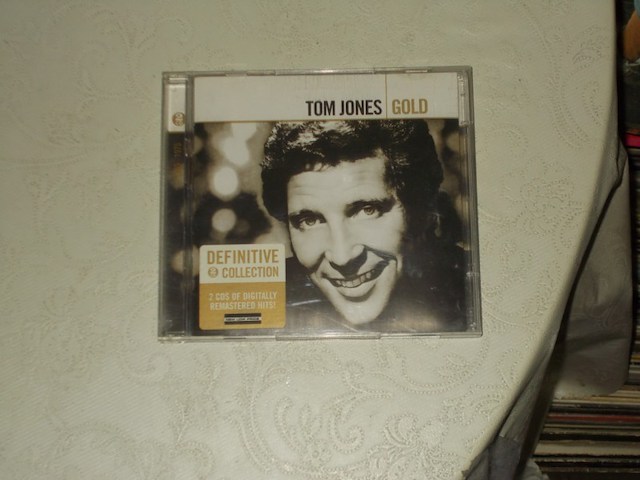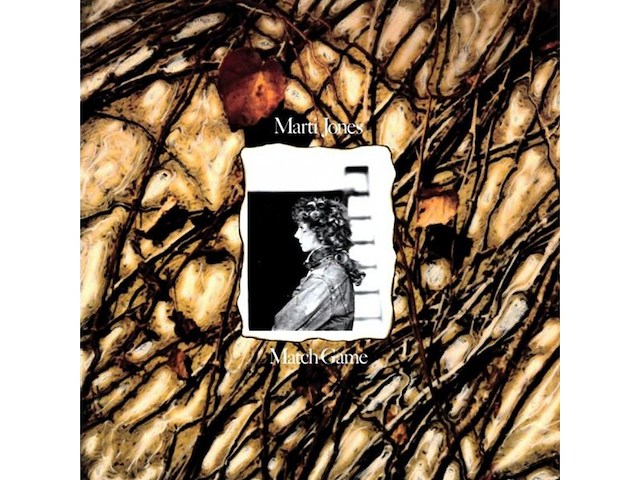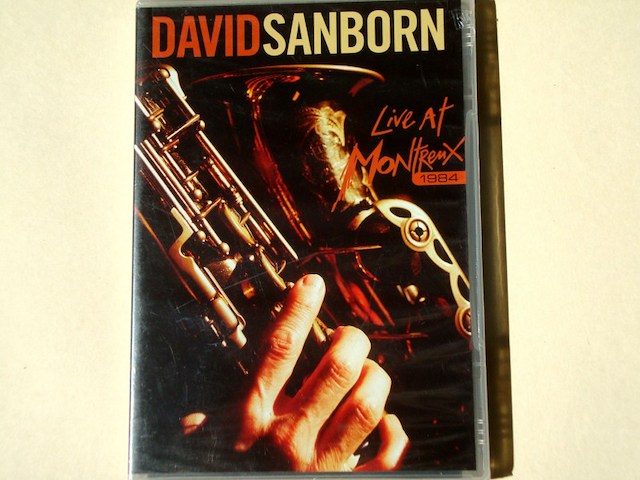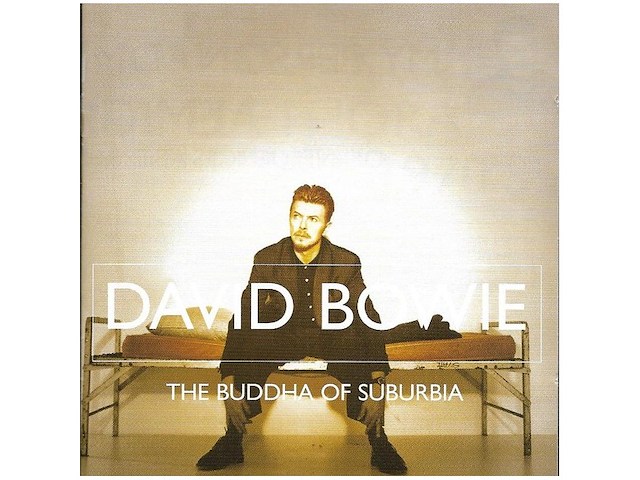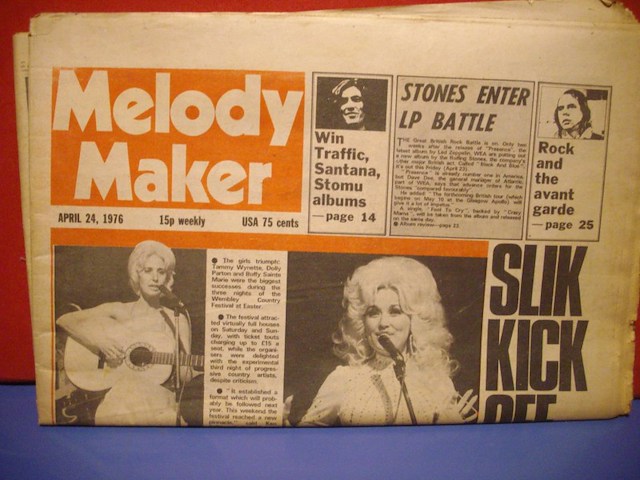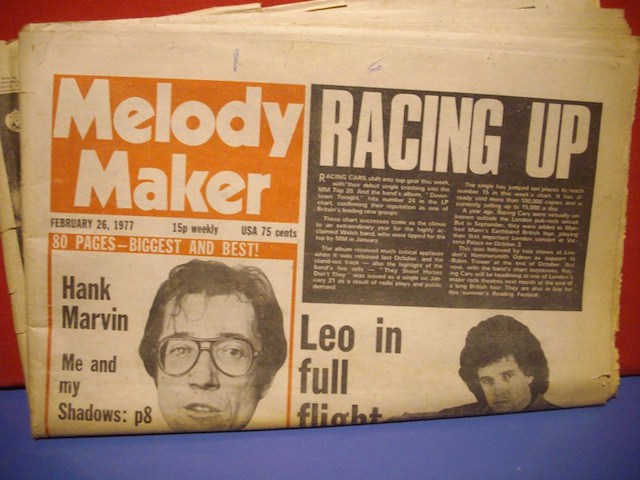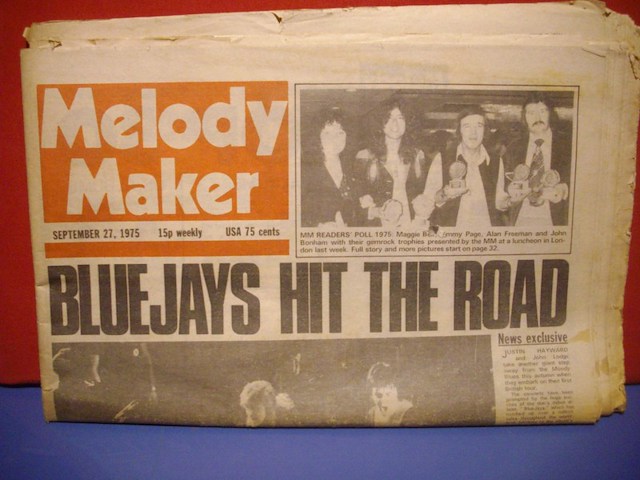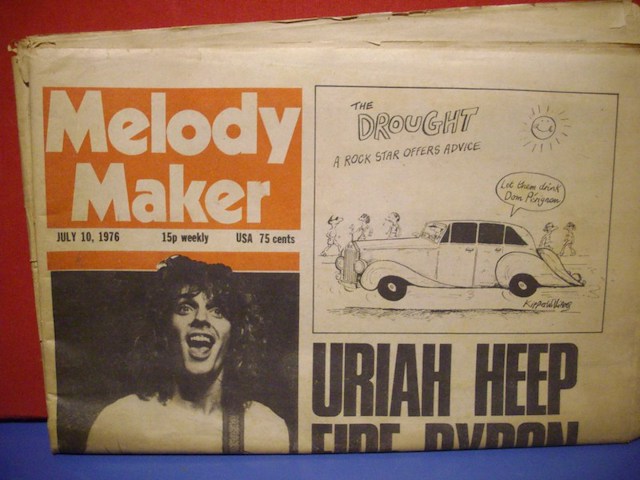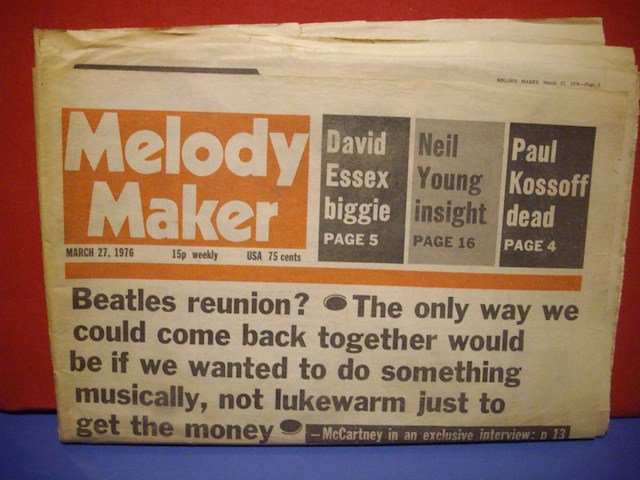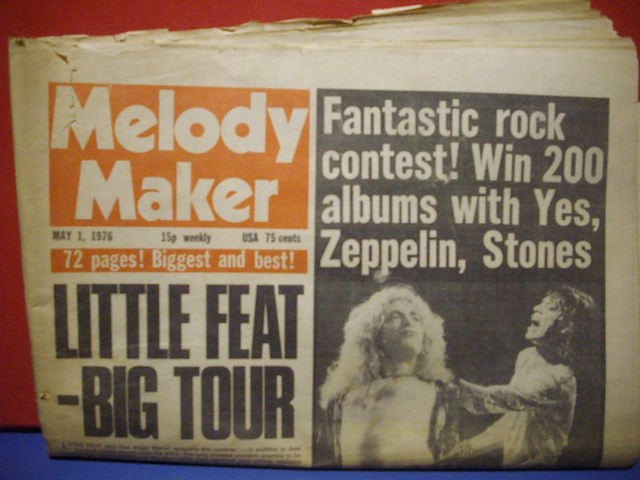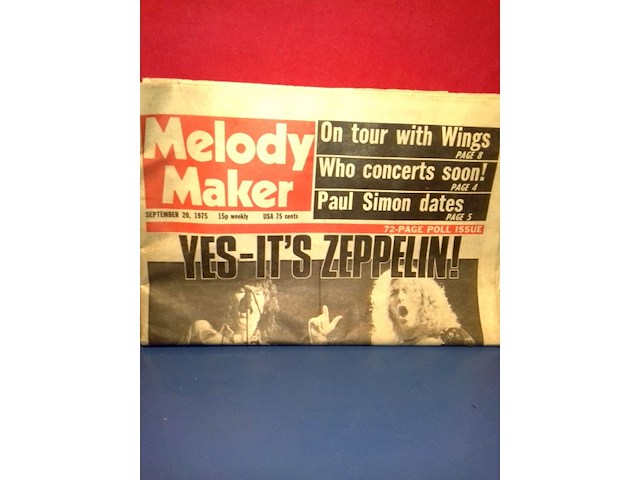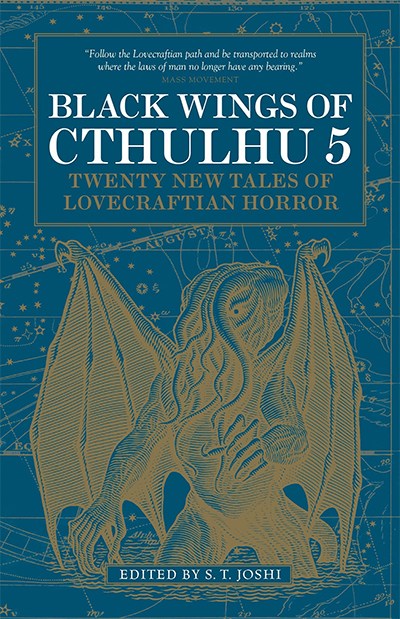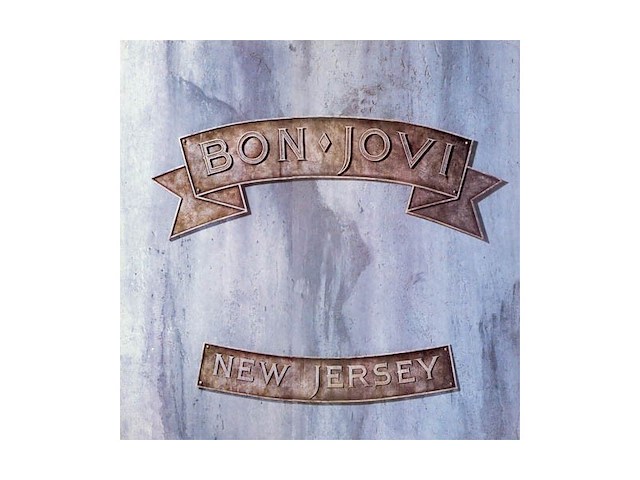Pratite promene cene putem maila
- Da bi dobijali obaveštenja o promeni cene potrebno je da kliknete Prati oglas dugme koje se nalazi na dnu svakog oglasa i unesete Vašu mail adresu.
1-25 od 140 rezultata
Prati pretragu "david jones"
Vi se opustite, Gogi će Vas obavestiti kad pronađe nove oglase za tražene ključne reči.
Gogi će vas obavestiti kada pronađe nove oglase.
Režim promene aktivan!
Upravo ste u režimu promene sačuvane pretrage za frazu .
Možete da promenite frazu ili filtere i sačuvate trenutno stanje
Aktivni filteri
-
Cena
1,000 din - 1,499 din
-
Kolekcionarstvo i umetnost chevron_right Knjige
The Little Guide to David Bowie Beloved by millions of fans the world, David Bowie was the ultimate icon, the perfect pop package that united sound with vison. In his fifty-year career, and across more than 26 studio albums, Bowie sold more than 140 million records, malking him one of the most successful artists of all time. Since his passing, he has been greatly missed, and remembered, by those who loved him the most. Filled with quotations by, and about, one of the most innovative artists in history. A perfect companion for Bowie fans everywhere, this collection of bite-sized quips helps capture exactly what made Ziggy Stardust so special. From insightful quotes by fellow artists, collaborators, and friends, to words of wit and wisdom from David Robert Jones himself, you'll find more than 170 amusing and inspiring soundbites inside.
-
Kolekcionarstvo i umetnost chevron_right Muzika i film
Booklet 5- / CD 5 Rickie Lee Jones – Pirates Rickie Lee Jones - Pirates album cover Label: Warner Bros. Records – 3432-2, Warner Bros. Records – 256 816 Format: CD, Album, Club Edition Country: US Released: Genre: Jazz, Funk / Soul, Pop Style: Rhythm & Blues 1 We Belong Together Drums – Steve Gadd Guitar – Buzzy Feiten, Dean Parks, Steve Lukather Keyboards – Neil Larsen, Russell Ferrante Keyboards, Synthesizer – Rickie Lee Jones Synthesizer – Michael Boddicker 4:59 2 Living It Up Drums – Art Rodriguez Guitar – Buzzy Feiten, Dean Parks, Steve Lukather Keyboards – Neil Larsen, Russell Ferrante Keyboards, Synthesizer – Rickie Lee Jones Synthesizer – Michael Boddicker Vocals – Sal Bernardi 6:23 3 Skeletons Guitar – Buzzy Feiten, Dean Parks, Steve Lukather Keyboards – Clarence McDonald, Randy Kerber Synthesizer – Michael Boddicker, Rickie Lee Jones 3:37 4 Woody And Dutch On The Slow Train To Peking Drums [Boxes And Thighs] – Steve Gadd Guitar – David Kalish Keyboards – Neil Larsen, Russell Ferrante Keyboards, Synthesizer, Vocals [Background] – Rickie Lee Jones Saxophone [Alto] – David Sanborn Synthesizer – Michael Boddicker Tenor Saxophone, Baritone Saxophone – Tom Scott Trumpet, Flugelhorn – Randy Brecker Vocals [Background] – Arno Lucas, Joe Turano, Leslie Smith 5:15 5 Pirates (So Long Lonely Avenue) Drums – Steve Gadd Guitar – Buzzy Feiten, Dean Parks, Steve Lukather Harmonica – Sal Bernardi Keyboards – Neil Larsen, Russell Ferrante Keyboards, Synthesizer – Rickie Lee Jones Saxophone [Alto] – David Sanborn Synthesizer – Donald Fagen, Michael Boddicker, Rob Mounsey Tenor Saxophone, Baritone Saxophone – Tom Scott Trumpet, Flugelhorn – Randy Brecker 3:50 6 A Lucky Guy Drums – Art Rodriguez Guitar – Buzzy Feiten, Dean Parks, Steve Lukather Keyboards – Neil Larsen, Russell Ferrante Keyboards, Synthesizer – Rickie Lee Jones Synthesizer – Michael Boddicker 4:14 7 Traces Of The Western Slopes Drums – Art Rodriguez Guitar – Buzzy Feiten, Dean Parks, Steve Lukather Harmonica, Vocals – Sal Bernardi Keyboards – Neil Larsen, Russell Ferrante Keyboards, Synthesizer – Rickie Lee Jones Synthesizer – Michael Boddicker Trumpet, Flugelhorn – Jerry Hey 8:00 8 The Returns Guitar – Buzzy Feiten, Dean Parks, Steve Lukather Keyboards – Clarence McDonald, Randy Kerber Synthesizer – Michael Boddicker, Rickie Lee Jones 2:20 Arranged By [Horn And Vocal Arrangements] – Rickie Lee Jones Bass – Chuck Rainey Percussion – Lenny Castro, Victor Feldman Producer – Lenny Waronker, Russ Titelman BMG edition with the following in the place where barcode typically is placed: D 101790 Mfd. for BMG Direct Marketing, Inc. under License 6550 East 30th Street Indianapolis, Indiana 46219 The following is on the CD face under Warner Brothers copyright information on left side of the disc: Mfd. for BMG Direct Marketing Inc. under License D 101790 Following is printed on the back of the insert underneath catalog numbers on upper left hand side: D 101790
-
Kolekcionarstvo i umetnost chevron_right Knjige
Wing Jones Debut novel about a mixed-race family hit by tragedy in 90s Atlanta from a talented young writer. For fans of David Levithan, Jandy Nelson and Rainbow Rowell: a sweeping story about love and family from an exceptional new voice in YA. With a grandmother from China and another from Ghana, fifteen-year-old Wing Jones is often caught between worlds. But when tragedy strikes, Wing discovers a talent for running she never knew she had. Wing's speed could bring her family everything it needs. It could also stop Wing getting the one thing she wants.
-
Kolekcionarstvo i umetnost chevron_right Knjige
Unquiet Landscape: Places And Ideas In 20th-Century British Painting Christopher Neves classic book is a journey into the imagination through the English landscape. How is it that artists, by thinking in paint, have come to regard the landscape as representing states of mind? Painting, says Neve, is a process of finding out, and landscape can be its thesis. What he is writing is not precisely art history: it is about pictures, about landscape and about thought. Over the years, he was able to have discussions with many of the thirty or so artists he focuses on, the inspiration for the book having come from his talks with Ben Nicholson; and he has immersed himself in their work, their countryside, their ideas. Because he is a painter himself, and an expert on 20th-century art, Neve is well equipped for such a journey. Few writers have conveyed more vividly the mixture of motives, emotions, unconscious forces and contradictions which culminate in the creative act of painting. Each of the thirteen chapters has a theme and explores its significance for one or more of the artists. The problem of time, for instance, is considered in relation to Paul Nash, God in relation to David Jones, music to Ivon Hitchens, hysteria to Edward Burra, abstraction to Ben Nicholson, the spirit in the mass to David Bomberg. There are also chapters about painters ideas on specific types of country: about Eric Ravilious and the chalk landscape, Joan Eardley and the sea, and Cedric Morris and the garden. Prikaži više
-
Kolekcionarstvo i umetnost chevron_right Muzika i film
PLOCA 5 OMOT 4+ David Bowie – Time Will Crawl (Extended Dance Mix) David Bowie - Time Will Crawl (Extended Dance Mix) album cover More images Label: EMI America – V-19247 Format: Vinyl, 12`, 33 ⅓ RPM Country: US Released: 1987 Genre: Electronic, Rock Style: New Wave, Pop Rock A1 Time Will Crawl (Extended Dance Mix) Producer [Additional Production], Remix – David Richards Written-By – David Bowie 6:11 A2 Time Will Crawl Written-By – David Bowie 4:18 B1 Girls (Extended Edit) Lyrics By – David Bowie Music By – David Bowie, Erdal Kizilcay 5:34 B2 Girls (Japanese Version) Lyrics By – David Bowie Music By – David Bowie, Erdal Kizilcay Other [Japanese Coach] – Kiri Teshigahara Translated By [Japanese Translation] – Hiro Hozumi 4:00 Phonographic Copyright ℗ – David Bowie Copyright © – David Bowie Licensed To – EMI AMERICA Records Published By – Jones Music America Manufactured By – Capitol Records, Inc. Lacquer Cut At – Masterdisk Pressed By – Specialty Records Corporation Design – Mick Haggerty Photography By – Greg Gorman Producer – David Bowie, David Richards Album version can be heard on the LP, `Never Let Me Down`-PJ-17267 Jones Music America-ASCAP ©℗1987 David Bowie under license to EMI America Records, a division of Capitol Records Inc. Manufactured in the U.S.A. By Capitol Records Inc., a subsidiary of Capitol Industries-EMI Inc. Printed in U.S.A. X503004B X503004 X503007 X503390 Barcode: 0 7777-19247-1 2 Matrix / Runout (Runout Side A, Variant 1): V-1-19247-Z1 MASTERDISK SRC Matrix / Runout (Runout Side B, Variant 1): V-2-19247-Z2 1-1 SRC Matrix / Runout (Runout Side A, Variant 2): V-1-19247-Z1 MASTERDISK SRC Matrix / Runout (Runout Side B, Variant 2): V-2-19247-Z1 1-1 SRC
Autori Mary Jones, Diane Fellowes Freeman, David Sang Broj stranica Povez Meki povez Pismo Latinica Godina izdanja 2020 ISBN13 Broj odluke Ministarstva 650-02-00654/2019-07, od 19.05.2020 Broj izdanja Status izdanja Format Oblik Razred 6 Predmet Biologija Jezik nastave Albanski jezik Šifra kompleta 523ALB6BIO Udžbenička jedinica Izdavač Albas doo
Biologija 8, Cambridge Checkpoint Science Coursebook 8 (Биологија 8) за седми разред основне школе на албанском језику и писму
Autori Mary Jones, Diane Felloves- Freeman и David Sang Broj stranica Povez Meki povez Pismo Latinica Godina izdanja 2022 ISBN13 Broj odluke Ministarstva 650-02-00072/2021-07 од 16.12.2021. Broj izdanja Status izdanja Format A4 Oblik Štampani Razred 7 Predmet Biologija Jezik nastave Albanski jezik Šifra kompleta 300005ALB7BIO Udžbenička jedinica Izdavač Albas doo
Autori Mary Jones, Diane Felloves- Freeman и David Sang Broj stranica Povez Meki povez Pismo Latinica Godina izdanja 2022 ISBN13 Broj odluke Ministarstva 650-02-00069/2021-07 од 16.12.2021. Broj izdanja Status izdanja Format A4 Oblik Štampani Razred 8 Predmet Fizika Jezik nastave Albanski jezik Šifra kompleta 90023ALB8FIZ Udžbenička jedinica Izdavač Albas doo
-
Kolekcionarstvo i umetnost chevron_right Muzika i film
Conjure – Music For The Texts Of Ishmael Reed PANGÆA PEA 461155 2 1 Jes` Grew 4:03 2 The Wardrobe Master Of Paradise 5:41 3 Dualism (1) 2:47 4 Oakland Blues 4:26 5 Skydiving 4:14 6 Judas 2:14 7 Betty Ball`s Blues 3:41 8 Untitled II 3:35 9 Fool-Ology (The Song) 6:07 10 From The Files Of Agent 22 3:18 11 Dualism (2) 3:37 12 Rhythm In Philosophy 1:38 Engineer – David Rodriguez, Emilsam Velazquez*, Frank Rodriguez Executive Producer – Scott Marcus Liner Notes – Don Palmer Mastered By – Jack Adelman Mixed By – David Rodriguez, Jon Fausty Photography By – Ming Smith, Spencer Richards Producer – Kip Hanrahan Recorded By [Assistant] – Edwin Ayala, Horacio Malvicino Jr.* Recorded August, September and October 1983; Latin/Eurosound Studios, New York City ⓅⒸ 1984 American Clave stanje diska: 4/5 stanje omota: 5/5
-
Kolekcionarstvo i umetnost chevron_right Muzika i film
Label: Deram – 0602498209714 Series: Gold (8) – Format: 2 × CD, Compilation, Remastered Country: Europe Style: Vocal, Soul, Ballad TracklistHide Credits 1-1 It`s Not Unusual Written-By – Mills*, Reed* 1:59 1-2 Once Upon A Time Written-By – Mills* 2:10 1-3 With These Hands Written-By – Silver*, Davis* 2:41 1-4 What`s New Pussycat Written-By – David / Bacharach* 2:18 1-5 Thunderball Written-By – Black*, Barry* 2:51 1-6 Promise Her Anything Written-By – David / Bacharach* 2:33 1-7 To Make A Big Man Cry Written-By – Reed*, Callander* 2:45 1-8 Stop Breaking My Heart Written-By – Mills*, Harris* 2:26 1-9 Once There Was A Time Written-By – Climax (19), Callander*, Del Monaco* 2:25 1-10 Not Responsible Written-By – Mills* 2:07 1-11 This And That Written-By – Dorsey* 2:58 1-12 Green, Green Grass Of Home Written-By – Putman* 3:04 1-13 Detroit City Written-By – Dill*, Tillis* 3:31 1-14 Funny Familiar Forgotten Feelings Written-By – Newbury* 2:55 1-15 Sixteen Tons Written-By – Travis* 3:07 1-16 (It Looks Like) I`ll Never Fall In Love Again Written-By – Currie*, Donegan* 4:13 1-17 I`m Coming Home Written-By – Mason*, Reed* 3:06 1-18 I Wake Up Crying Written-By – Hal David 2:18 1-19 Delilah Written-By – Mason*, Reed* 3:22 1-20 Help Yourself Written-By – Donida*, Rapetti*, Fishman* 2:53 1-21 A Minute Of Your Time Written-By – Westlake* 2:56 1-22 Looking Out My Window Written-By – Jones* 2:19 2-1 Love Me Tonight 3:11 2-2 I Can`t Turn You Loose Written-By – Redding* 2:09 2-3 Without Love (There Is Nothing) Written-By – Small* 3:44 2-4 Let There Be Love Written-By – B.,R. & M. Gibb* 3:35 2-5 Daughter Of Darkness 3:15 2-6 I (Who Have Nothing) Written-By – Leiber & Stoller 2:56 2-7 Can`t Stop Loving You Written-By – Waddington*, Bickerton* 4:08 2-8 She`s A Lady Written-By – Anka* 2:52 2-9 Do What You Gotta Do Written-By – Webb* 2:51 2-10 Puppet Man Written-By – Greenfield*, Sedaka* 3:23 2-11 You`re My World (Il Mio Mondo) 3:24 2-12 Till 2:17 2-13 The Young New Mexican Puppeteer 4:34 2-14 The Witch Queen Of New Orleans Written-By – Vegas / Vegas* 2:34 2-15 Letter To Lucille Written-By – Macaulay* 3:03 2-16 Ain`t No Sunshine Written-By – Withers* 2:36 2-17 (If Loving You Is Wrong) I Don`t Wanna Be Right 3:26 2-18 Pledging My Love Written-By – Robey*, Washington* 2:50 2-19 I Got Your Number Written-By – Reeves*, Bristol* 3:24 2-20 Memories Don`t Leave Like People Do Written-By – Bristol* 4:17 CD-ovi 5, 5- Buklet 4+,12 stranica,VRLO DOBAR
-
Kolekcionarstvo i umetnost chevron_right Muzika i film
Ploca je u odlicnom stanju. Vinil (4+) Omot (5) Made in Germany Spisak numera: Tracklist Hide Credits A1 We`re Doing Alright Acoustic Guitar – Jim Maestro*, Marti*Bass, Finger Snaps, Organ, Vocals – Dixon*Drums, Percussion, Finger Snaps – Mickey CurryElectric Guitar – Ricky ByrdVocals – Darlene Love, Nancy Jeffries (2)Written-By – Reed Nielsen 4:12 A2 Chance Of A Lifetime Acoustic Guitar – Marti*Acoustic Guitar, Vocals – Dixon*Bass – Rick FordDrums – Gary BurkeElectric Guitar – Vinnie ZummoGuitar [Solo] – Mitch EasterVocals – Treva SpontaineWritten-By – Dwight Twilley 3:18 A3 Be Myself Again Acoustic Guitar, Synthesizer – Marti*Drums – Robert CrenshawElectric Guitar – Mitch EasterElectric Guitar, Piano, Acoustic Guitar, Vocals – Dixon*Twelve-String Guitar – Marshall CrenshawWritten-By – Don Dixon, Marti Jones 3:40 A4 Just A Memory Bass, Acoustic Guitar, Organ, Vocals – Dixon*Drums – Robert CrenshawElectric Guitar – Marshall CrenshawGuitar [Vibrato Guitar] – T-Bone BurnettPiano – Paul CarrackVocals – Anne Richmond BostonWritten-By – Elvis Costello 4:11 A5 Touch Tone Percussion, Synthesizer, Piano, Voice – Dixon*Written-By – Don Dixon 3:21 A6 Foolish Lies Acoustic Guitar – Marti*Bass, Organ [Talking Organ], Piano, Vocals – Dixon*Drums – Mickey CurryElectric Guitar, Guitar [Solo] – Vinnie ZummoKeyboards, Synthesizer – Richard PutnamVocals – Anne Richmond BostonWritten-By – Richard Barone 4:08 B1 Inside These Arms Drums – Mickey CurryElectric Guitar – Mitch Easter, Vinnie ZummoVocals – Anne Richmond BostonWritten-By, Vocals, Bass, Synthesizer – Don Dixon 5:01 B2 Whenever You`re On My Mind Acoustic Guitar – Marti*Acoustic Guitar, Guitar [Vibrato] – Mitch EasterBass – Rick FordDrums – Gary BurkeElectric Guitar – Vinnie ZummoVocals – Treva SpontaineVocals, Guitar [High String], Guitar [Backbeat] – Dixon*Written-By – Bill Teeley, Marshall Crenshaw 3:11 B3 Crusher Accordion – Vinnie ZummoAcoustic Bass – Jack HerrickAcoustic Guitar [Slide] – Frank ChristianChatan, Percussion – Aiyb DiengElectric Guitar – Mitch EasterOther [Broken Stick] – Dixon*Written-By – Liam Sternberg 4:01 B4 It`s Too Late Bass, Guitar, Vocals, Piano [Tack] – Dixon*Drums – Robert CrenshawElectric Guitar [Solo], Vocals – Marshall CrenshawHandclaps – Ariel WarnerHandclaps, Acoustic Guitar – Marti*Vocals – Richard BaroneWritten-By – John David 3:38 B5 Soon I Will Be Gone Acoustic Guitar – Marti*Bass, Vocals – Dixon*Cello – Martin LovedayDrums – Terry SilverlightGuitar [Fuzz with Matamp] – Mitch EasterGuitar [Leslie] – Vinnie ZummoViola – George RobertsonViolin [1st] – Gavyn WrightViolin [2nd] – Wilfred Gibson*Vocals – Anne Richmond BostonWritten-By – Andy Fraser, Paul Rodgers 3:00 B6 Soul Love Acoustic Guitar – Marti*Bass, Piano, Vocals – Dixon*Chatan – Aiyb DiengDrums – Terry SilverlightElectric Guitar – Vinnie ZummoSaxophone – Gary BarnacleWritten-By – David Bowie
-
Kolekcionarstvo i umetnost chevron_right Muzika i film
David Sanborn - Live At Montreux 1984 Originalno izdanje. DVD: NTSC Made in Europe Novo, neotpakovano, u celofanu! Sadrzaj: 1984 01 Hideaway 02 I Told U So 03 Straight To The Heart 04 Autumn Leaves [Featuring Rickie Lee Jones] 05 Guitar Solo 06 Rush Hour 07 Piano Solo 08 Smile 09 Morning Salsa Bonus Tracks 1981 10 Love Is Not Enough 11 Lotus Blossom 12 Hideaway Sve tehnicke podatke o izdanju mozete videti na slici, ukoliko ima dodatnih pitanja, rado cu odgovoriti. Stanje mozete videti na slikama. Zanrovi: jazz, rock, fusion pvs1r11
-
Kolekcionarstvo i umetnost chevron_right Muzika i film
Omot kao na slikama, ploča 5-/4+ Bon Jovi – Bon Jovi Label:PGP RTB – 2222388, Mercury – 814 982-1 Format:Vinyl, LP, Album Country:Yugoslavia Released:1984 Genre:Rock Style:Hard Rock, Pop Rock, Glam Tracklist A1 Runaway Backing Vocals – David Grahmme*, J.B.*, Mick Seeley Bass – Huey McDonald* Drums – Frankie La Rocka* Guitar [Guitars] – Tim Pierce Keyboards – Roy Bittan Lead Vocals – J.B.* Written-By – G. Karak*, J. Bon Jovi* 3:54 A2 Roulette Written-By – J. Bon Jovi*, R. Sambora* 4:41 A3 She Don`t Know Me Written-By – M. Avsec* 4:04 A4 Shot Through The Heart Written-By – J. Ponti*, J. Bon Jovi* 4:24 A5 Love Lies Written-By – D. Rashbaum*, J. Bon Jovi* 4:03 B1 Breakout Written-By – D. Rashbaum*, J. Bon Jovi* 5:22 B2 Burning For Love Written-By – J. Bon Jovi*, R. Sambora* 3:52 B3 Come Back Written-By – J. Bon Jovi*, R. Sambora* 3:57 B4 Get Ready Written-By – J. Bon Jovi*, R. Sambora* 4:08 Credits Art Direction – Bill Levy, Spencer Drate Backing Vocals – Alec John Such, David Rashbaum, Jon Bon Jovi, Richie Sambora Bass – Alec John Such Design [Album Design] – Judith Salavetz, Spencer Drate Design [Inner Sleeve Logo Design] – Anthony Michael Bongiovi* Drums – Tico Torres (`The Hit Man`)* Engineer – Jeff Hendrickson, Larry Alexander, Scott Litt Engineer [Assistant] – Barry Bongiovi, Bruce Lampcov, Dave Greenberg, Gary Rindfuss*, Jon Babich* Executive-Producer – Arthur Mann Keyboards – David Rashbaum Lead Guitar – Richie Sambora Lead Vocals, Guitar – Jon Bon Jovi Management – Doc McGhee Mastered By – Bob Ludwig Other [Coat] – Ariel Other [Legs & Looks] – Ellen Parker Other [Make Up] – Sonia DeMelo Other [Slyling] – Melissa Chatain Performer [Additional Musicians] – Aldo Nova, Chuck Bürgi, Doug Katsoras*, Huey McDonald* Photography By [Concept Photography & Tinting] – Geoffrey Thomas (2) Producer – Lance Quinn, Tony Bongiovi Barcode and Other Identifiers Matrix / Runout (side A runout area): 2222388 A 17984 Matrix / Runout (side A runout area): 2222388 B 17984 Rights Society: SOKOJ
-
Kolekcionarstvo i umetnost chevron_right Muzika i film
OMOT 5 CD 5 MINT David Bowie - The Buddha Of Suburbia album cover More images Label: EMI – 50999 5 00463 2 4, EMI – 500 4632 Format: CD, Album, Reissue Country: Europe Released: 2007 Genre: Electronic, Rock Style: Art Rock, Pop Rock 1 Buddha Of Suburbia 4:28 2 Sex And The Church 6:25 3 South Horizon Piano – Mike Garson Recorded By [Mike Garson Piano] – Mike Ruggieri 5:26 4 The Mysteries 7:12 5 Bleed Like A Craze, Dad Drums, Bass, Guitar – 3D Echo 5:22 6 Strangers When We Meet 4:58 7 Dead Against It 5:48 8 Untitled No. 1 5:01 9 Ian Fish, U.K. Heir 6:27 10 Buddha Of Suburbia Guitar – Lenny Kravitz 4:19 Phonographic Copyright ℗ – Jones/Tintoretto Entertainment Co., LLC Copyright © – Jones/Tintoretto Entertainment Co., LLC Copyright © – EMI Records Ltd. Licensed To – EMI Records Ltd. Published By – Tintoretto Music Published By – RZO Music Ltd. Marketed By – EMI Distributed By – EMI Pressed By – www.mediamotion.com Recorded At – Mountain Studios Recorded At – O`Henry Sound Studios Mixed At – Mountain Studios Concept By [Re-issue Cover Colour Concept] – Mark Adams (11) Coordinator [Project Co-ordinated By For EMI] – Jo Brooks, Nigel Reeve Coordinator [Project Co-ordinated By For RZO Music] – Henry Wrenn-Meleck Design – Reiner Design*, Roger Gorman Engineer [Assistant] – Dominik Taqua* Engineer [Engineering], Programmed By – Dave Richards* Keyboards, Trumpet, Bass, Guitar, Percussion – Erdal Kizilcay Lyrics By, Music By, Liner Notes – David Bowie Photography By – John Jefford Photography By [Cover] – Frank Ockenfels 3* Producer, Mixed By – David Bowie, Dave Richards* Vocals, Keyboards, Synthesizer, Guitar, Alto Saxophone, Baritone Saxophone, Percussion [Keyboard Percussion] – David Bowie CD reissue of the 1993 album. Produced and mixed at Mountain Studio, Montreux, Switzerland. Mike Garson piano recorded at O`Henry Sound, Burbank, California. Lenny Kravitz appears courtesy of virgin Records. All songs published by Tintoretto Music (BMI) administered by RZO Music, Inc. (North America), Tintoretto Music/RZO Music Ltd. (Rest of World) ℗ 1993 The copyright in this sound recording is owned by Jones/Tintoretto Entertainment Company LLC under exclusive license to EMI Records Ltd. © 2007 Jones/Tintoretto Entertainment Company LLC under exclusive license to EMI Records Ltd. This label copy information is the subject of copyright protection. All rights reserved. © 2003 EMI Records Ltd. Printed in the EU. Jewel case with 12-page booklet. Barcode (Text): 5 099950 046324
-
Kolekcionarstvo i umetnost chevron_right Muzika i film
Veliki format, presavijen Melody Maker was a British weekly music magazine, one of the world`s earliest music weeklies, and—according to its publisher IPC Media—the earliest.[2] It was founded in 1926, largely as a magazine for dance band musicians,[3] by Leicester-born composer, publisher Lawrence Wright; the first editor was Edgar Jackson.[4][5] In 2000 it was merged into `long-standing rival`[2] (and IPC Media sister publication) New Musical Express. By the early 1970s, Melody Maker was considered `the musos` journal` and associated with progressive rock. However, Melody Maker also reported on teenybopper pop sensations like the Osmonds, the Jackson 5, and David Cassidy. The music weekly also gave early and sympathetic coverage to glam rock. Richard Williams wrote the first pieces about Roxy Music, while Roy Hollingworth wrote the first article celebrating New York Dolls in proto-punk terms while serving as the Melody Maker`s New York correspondent. In January 1972, Michael `Mick` Watts, a prominent writer for the paper,[13] wrote a profile of David Bowie that almost singlehandedly ignited the singer`s dormant career.[14] During the interview Bowie claimed, `I`m gay, and always have been, even when I was David Jones.`[15] `OH YOU PRETTY THING` ran the headline, and swiftly became part of pop mythology. Bowie later attributed his success to this interview, stating that, `Yeah, it was Melody Maker that made me. It was that piece by Mick Watts.`[16] During his tenure at the paper, Watts also toured with and interviewed artists including Syd Barrett, Waylon Jennings, Pink Floyd, Bob Dylan and Bruce Springsteen. Caroline Coon was headhunted by Melody Maker editor Ray Coleman in the mid-1970s and promptly made it her mission to get women musicians taken seriously. Between 1974 and 1976, she interviewed Maggie Bell, Joan Armatrading, Lynsey de Paul, and Twiggy. She then went on to make it her mission to promote punk rock.[17] In 1978, Richard Williams returned – after a stint working at Island Records – to the paper as the new editor and attempted to take Melody Maker in a new direction, influenced by what Paul Morley and Ian Penman were doing at NME. He recruited Jon Savage (formerly of Sounds), Chris Bohn and Mary Harron to provide intellectual coverage of post-punk bands like Gang of Four, Pere Ubu and Joy Division and of new wave in general. Vivien Goldman, previously at NME and Sounds, gave the paper much improved coverage of reggae and soul music, restoring the superior coverage of those genres that the paper had in the early 1970s. Despite this promise of a new direction for the paper, internal tension developed, principally between Williams and Coleman, by this time editor-in-chief, who wanted the paper to stick to the more `conservative rock` music it had continued to support during the punk era. Coleman had been insistent that the paper should `look like The Daily Telegraph` (renowned for its old-fashioned design), but Williams wanted the paper to look more contemporary. He commissioned an updated design, but this was rejected by Coleman.
-
Kolekcionarstvo i umetnost chevron_right Muzika i film
Veliki format, presavijen Melody Maker was a British weekly music magazine, one of the world`s earliest music weeklies, and—according to its publisher IPC Media—the earliest.[2] It was founded in 1926, largely as a magazine for dance band musicians,[3] by Leicester-born composer, publisher Lawrence Wright; the first editor was Edgar Jackson.[4][5] In 2000 it was merged into `long-standing rival`[2] (and IPC Media sister publication) New Musical Express. By the early 1970s, Melody Maker was considered `the musos` journal` and associated with progressive rock. However, Melody Maker also reported on teenybopper pop sensations like the Osmonds, the Jackson 5, and David Cassidy. The music weekly also gave early and sympathetic coverage to glam rock. Richard Williams wrote the first pieces about Roxy Music, while Roy Hollingworth wrote the first article celebrating New York Dolls in proto-punk terms while serving as the Melody Maker`s New York correspondent. In January 1972, Michael `Mick` Watts, a prominent writer for the paper,[13] wrote a profile of David Bowie that almost singlehandedly ignited the singer`s dormant career.[14] During the interview Bowie claimed, `I`m gay, and always have been, even when I was David Jones.`[15] `OH YOU PRETTY THING` ran the headline, and swiftly became part of pop mythology. Bowie later attributed his success to this interview, stating that, `Yeah, it was Melody Maker that made me. It was that piece by Mick Watts.`[16] During his tenure at the paper, Watts also toured with and interviewed artists including Syd Barrett, Waylon Jennings, Pink Floyd, Bob Dylan and Bruce Springsteen. Caroline Coon was headhunted by Melody Maker editor Ray Coleman in the mid-1970s and promptly made it her mission to get women musicians taken seriously. Between 1974 and 1976, she interviewed Maggie Bell, Joan Armatrading, Lynsey de Paul, and Twiggy. She then went on to make it her mission to promote punk rock.[17] In 1978, Richard Williams returned – after a stint working at Island Records – to the paper as the new editor and attempted to take Melody Maker in a new direction, influenced by what Paul Morley and Ian Penman were doing at NME. He recruited Jon Savage (formerly of Sounds), Chris Bohn and Mary Harron to provide intellectual coverage of post-punk bands like Gang of Four, Pere Ubu and Joy Division and of new wave in general. Vivien Goldman, previously at NME and Sounds, gave the paper much improved coverage of reggae and soul music, restoring the superior coverage of those genres that the paper had in the early 1970s. Despite this promise of a new direction for the paper, internal tension developed, principally between Williams and Coleman, by this time editor-in-chief, who wanted the paper to stick to the more `conservative rock` music it had continued to support during the punk era. Coleman had been insistent that the paper should `look like The Daily Telegraph` (renowned for its old-fashioned design), but Williams wanted the paper to look more contemporary. He commissioned an updated design, but this was rejected by Coleman.
-
Kolekcionarstvo i umetnost chevron_right Muzika i film
Veliki format, presavijen Melody Maker was a British weekly music magazine, one of the world`s earliest music weeklies, and—according to its publisher IPC Media—the earliest.[2] It was founded in 1926, largely as a magazine for dance band musicians,[3] by Leicester-born composer, publisher Lawrence Wright; the first editor was Edgar Jackson.[4][5] In 2000 it was merged into `long-standing rival`[2] (and IPC Media sister publication) New Musical Express. By the early 1970s, Melody Maker was considered `the musos` journal` and associated with progressive rock. However, Melody Maker also reported on teenybopper pop sensations like the Osmonds, the Jackson 5, and David Cassidy. The music weekly also gave early and sympathetic coverage to glam rock. Richard Williams wrote the first pieces about Roxy Music, while Roy Hollingworth wrote the first article celebrating New York Dolls in proto-punk terms while serving as the Melody Maker`s New York correspondent. In January 1972, Michael `Mick` Watts, a prominent writer for the paper,[13] wrote a profile of David Bowie that almost singlehandedly ignited the singer`s dormant career.[14] During the interview Bowie claimed, `I`m gay, and always have been, even when I was David Jones.`[15] `OH YOU PRETTY THING` ran the headline, and swiftly became part of pop mythology. Bowie later attributed his success to this interview, stating that, `Yeah, it was Melody Maker that made me. It was that piece by Mick Watts.`[16] During his tenure at the paper, Watts also toured with and interviewed artists including Syd Barrett, Waylon Jennings, Pink Floyd, Bob Dylan and Bruce Springsteen. Caroline Coon was headhunted by Melody Maker editor Ray Coleman in the mid-1970s and promptly made it her mission to get women musicians taken seriously. Between 1974 and 1976, she interviewed Maggie Bell, Joan Armatrading, Lynsey de Paul, and Twiggy. She then went on to make it her mission to promote punk rock.[17] In 1978, Richard Williams returned – after a stint working at Island Records – to the paper as the new editor and attempted to take Melody Maker in a new direction, influenced by what Paul Morley and Ian Penman were doing at NME. He recruited Jon Savage (formerly of Sounds), Chris Bohn and Mary Harron to provide intellectual coverage of post-punk bands like Gang of Four, Pere Ubu and Joy Division and of new wave in general. Vivien Goldman, previously at NME and Sounds, gave the paper much improved coverage of reggae and soul music, restoring the superior coverage of those genres that the paper had in the early 1970s. Despite this promise of a new direction for the paper, internal tension developed, principally between Williams and Coleman, by this time editor-in-chief, who wanted the paper to stick to the more `conservative rock` music it had continued to support during the punk era. Coleman had been insistent that the paper should `look like The Daily Telegraph` (renowned for its old-fashioned design), but Williams wanted the paper to look more contemporary. He commissioned an updated design, but this was rejected by Coleman.
-
Kolekcionarstvo i umetnost chevron_right Muzika i film
Veliki format, presavijen Melody Maker was a British weekly music magazine, one of the world`s earliest music weeklies, and—according to its publisher IPC Media—the earliest.[2] It was founded in 1926, largely as a magazine for dance band musicians,[3] by Leicester-born composer, publisher Lawrence Wright; the first editor was Edgar Jackson.[4][5] In 2000 it was merged into `long-standing rival`[2] (and IPC Media sister publication) New Musical Express. By the early 1970s, Melody Maker was considered `the musos` journal` and associated with progressive rock. However, Melody Maker also reported on teenybopper pop sensations like the Osmonds, the Jackson 5, and David Cassidy. The music weekly also gave early and sympathetic coverage to glam rock. Richard Williams wrote the first pieces about Roxy Music, while Roy Hollingworth wrote the first article celebrating New York Dolls in proto-punk terms while serving as the Melody Maker`s New York correspondent. In January 1972, Michael `Mick` Watts, a prominent writer for the paper,[13] wrote a profile of David Bowie that almost singlehandedly ignited the singer`s dormant career.[14] During the interview Bowie claimed, `I`m gay, and always have been, even when I was David Jones.`[15] `OH YOU PRETTY THING` ran the headline, and swiftly became part of pop mythology. Bowie later attributed his success to this interview, stating that, `Yeah, it was Melody Maker that made me. It was that piece by Mick Watts.`[16] During his tenure at the paper, Watts also toured with and interviewed artists including Syd Barrett, Waylon Jennings, Pink Floyd, Bob Dylan and Bruce Springsteen. Caroline Coon was headhunted by Melody Maker editor Ray Coleman in the mid-1970s and promptly made it her mission to get women musicians taken seriously. Between 1974 and 1976, she interviewed Maggie Bell, Joan Armatrading, Lynsey de Paul, and Twiggy. She then went on to make it her mission to promote punk rock.[17] In 1978, Richard Williams returned – after a stint working at Island Records – to the paper as the new editor and attempted to take Melody Maker in a new direction, influenced by what Paul Morley and Ian Penman were doing at NME. He recruited Jon Savage (formerly of Sounds), Chris Bohn and Mary Harron to provide intellectual coverage of post-punk bands like Gang of Four, Pere Ubu and Joy Division and of new wave in general. Vivien Goldman, previously at NME and Sounds, gave the paper much improved coverage of reggae and soul music, restoring the superior coverage of those genres that the paper had in the early 1970s. Despite this promise of a new direction for the paper, internal tension developed, principally between Williams and Coleman, by this time editor-in-chief, who wanted the paper to stick to the more `conservative rock` music it had continued to support during the punk era. Coleman had been insistent that the paper should `look like The Daily Telegraph` (renowned for its old-fashioned design), but Williams wanted the paper to look more contemporary. He commissioned an updated design, but this was rejected by Coleman.
-
Kolekcionarstvo i umetnost chevron_right Muzika i film
Veliki format, presavijen Melody Maker was a British weekly music magazine, one of the world`s earliest music weeklies, and—according to its publisher IPC Media—the earliest.[2] It was founded in 1926, largely as a magazine for dance band musicians,[3] by Leicester-born composer, publisher Lawrence Wright; the first editor was Edgar Jackson.[4][5] In 2000 it was merged into `long-standing rival`[2] (and IPC Media sister publication) New Musical Express. By the early 1970s, Melody Maker was considered `the musos` journal` and associated with progressive rock. However, Melody Maker also reported on teenybopper pop sensations like the Osmonds, the Jackson 5, and David Cassidy. The music weekly also gave early and sympathetic coverage to glam rock. Richard Williams wrote the first pieces about Roxy Music, while Roy Hollingworth wrote the first article celebrating New York Dolls in proto-punk terms while serving as the Melody Maker`s New York correspondent. In January 1972, Michael `Mick` Watts, a prominent writer for the paper,[13] wrote a profile of David Bowie that almost singlehandedly ignited the singer`s dormant career.[14] During the interview Bowie claimed, `I`m gay, and always have been, even when I was David Jones.`[15] `OH YOU PRETTY THING` ran the headline, and swiftly became part of pop mythology. Bowie later attributed his success to this interview, stating that, `Yeah, it was Melody Maker that made me. It was that piece by Mick Watts.`[16] During his tenure at the paper, Watts also toured with and interviewed artists including Syd Barrett, Waylon Jennings, Pink Floyd, Bob Dylan and Bruce Springsteen. Caroline Coon was headhunted by Melody Maker editor Ray Coleman in the mid-1970s and promptly made it her mission to get women musicians taken seriously. Between 1974 and 1976, she interviewed Maggie Bell, Joan Armatrading, Lynsey de Paul, and Twiggy. She then went on to make it her mission to promote punk rock.[17] In 1978, Richard Williams returned – after a stint working at Island Records – to the paper as the new editor and attempted to take Melody Maker in a new direction, influenced by what Paul Morley and Ian Penman were doing at NME. He recruited Jon Savage (formerly of Sounds), Chris Bohn and Mary Harron to provide intellectual coverage of post-punk bands like Gang of Four, Pere Ubu and Joy Division and of new wave in general. Vivien Goldman, previously at NME and Sounds, gave the paper much improved coverage of reggae and soul music, restoring the superior coverage of those genres that the paper had in the early 1970s. Despite this promise of a new direction for the paper, internal tension developed, principally between Williams and Coleman, by this time editor-in-chief, who wanted the paper to stick to the more `conservative rock` music it had continued to support during the punk era. Coleman had been insistent that the paper should `look like The Daily Telegraph` (renowned for its old-fashioned design), but Williams wanted the paper to look more contemporary. He commissioned an updated design, but this was rejected by Coleman.
-
Kolekcionarstvo i umetnost chevron_right Muzika i film
Veliki format, presavijen Melody Maker was a British weekly music magazine, one of the world`s earliest music weeklies, and—according to its publisher IPC Media—the earliest.[2] It was founded in 1926, largely as a magazine for dance band musicians,[3] by Leicester-born composer, publisher Lawrence Wright; the first editor was Edgar Jackson.[4][5] In 2000 it was merged into `long-standing rival`[2] (and IPC Media sister publication) New Musical Express. By the early 1970s, Melody Maker was considered `the musos` journal` and associated with progressive rock. However, Melody Maker also reported on teenybopper pop sensations like the Osmonds, the Jackson 5, and David Cassidy. The music weekly also gave early and sympathetic coverage to glam rock. Richard Williams wrote the first pieces about Roxy Music, while Roy Hollingworth wrote the first article celebrating New York Dolls in proto-punk terms while serving as the Melody Maker`s New York correspondent. In January 1972, Michael `Mick` Watts, a prominent writer for the paper,[13] wrote a profile of David Bowie that almost singlehandedly ignited the singer`s dormant career.[14] During the interview Bowie claimed, `I`m gay, and always have been, even when I was David Jones.`[15] `OH YOU PRETTY THING` ran the headline, and swiftly became part of pop mythology. Bowie later attributed his success to this interview, stating that, `Yeah, it was Melody Maker that made me. It was that piece by Mick Watts.`[16] During his tenure at the paper, Watts also toured with and interviewed artists including Syd Barrett, Waylon Jennings, Pink Floyd, Bob Dylan and Bruce Springsteen. Caroline Coon was headhunted by Melody Maker editor Ray Coleman in the mid-1970s and promptly made it her mission to get women musicians taken seriously. Between 1974 and 1976, she interviewed Maggie Bell, Joan Armatrading, Lynsey de Paul, and Twiggy. She then went on to make it her mission to promote punk rock.[17] In 1978, Richard Williams returned – after a stint working at Island Records – to the paper as the new editor and attempted to take Melody Maker in a new direction, influenced by what Paul Morley and Ian Penman were doing at NME. He recruited Jon Savage (formerly of Sounds), Chris Bohn and Mary Harron to provide intellectual coverage of post-punk bands like Gang of Four, Pere Ubu and Joy Division and of new wave in general. Vivien Goldman, previously at NME and Sounds, gave the paper much improved coverage of reggae and soul music, restoring the superior coverage of those genres that the paper had in the early 1970s. Despite this promise of a new direction for the paper, internal tension developed, principally between Williams and Coleman, by this time editor-in-chief, who wanted the paper to stick to the more `conservative rock` music it had continued to support during the punk era. Coleman had been insistent that the paper should `look like The Daily Telegraph` (renowned for its old-fashioned design), but Williams wanted the paper to look more contemporary. He commissioned an updated design, but this was rejected by Coleman.
-
Kolekcionarstvo i umetnost chevron_right Muzika i film
Veliki format, presavijen, kompletan Melody Maker was a British weekly music magazine, one of the world`s earliest music weeklies, and—according to its publisher IPC Media—the earliest.[2] It was founded in 1926, largely as a magazine for dance band musicians,[3] by Leicester-born composer, publisher Lawrence Wright; the first editor was Edgar Jackson.[4][5] In 2000 it was merged into `long-standing rival`[2] (and IPC Media sister publication) New Musical Express. By the early 1970s, Melody Maker was considered `the musos` journal` and associated with progressive rock. However, Melody Maker also reported on teenybopper pop sensations like the Osmonds, the Jackson 5, and David Cassidy. The music weekly also gave early and sympathetic coverage to glam rock. Richard Williams wrote the first pieces about Roxy Music, while Roy Hollingworth wrote the first article celebrating New York Dolls in proto-punk terms while serving as the Melody Maker`s New York correspondent. In January 1972, Michael `Mick` Watts, a prominent writer for the paper,[13] wrote a profile of David Bowie that almost singlehandedly ignited the singer`s dormant career.[14] During the interview Bowie claimed, `I`m gay, and always have been, even when I was David Jones.`[15] `OH YOU PRETTY THING` ran the headline, and swiftly became part of pop mythology. Bowie later attributed his success to this interview, stating that, `Yeah, it was Melody Maker that made me. It was that piece by Mick Watts.`[16] During his tenure at the paper, Watts also toured with and interviewed artists including Syd Barrett, Waylon Jennings, Pink Floyd, Bob Dylan and Bruce Springsteen. Caroline Coon was headhunted by Melody Maker editor Ray Coleman in the mid-1970s and promptly made it her mission to get women musicians taken seriously. Between 1974 and 1976, she interviewed Maggie Bell, Joan Armatrading, Lynsey de Paul, and Twiggy. She then went on to make it her mission to promote punk rock.[17] In 1978, Richard Williams returned – after a stint working at Island Records – to the paper as the new editor and attempted to take Melody Maker in a new direction, influenced by what Paul Morley and Ian Penman were doing at NME. He recruited Jon Savage (formerly of Sounds), Chris Bohn and Mary Harron to provide intellectual coverage of post-punk bands like Gang of Four, Pere Ubu and Joy Division and of new wave in general. Vivien Goldman, previously at NME and Sounds, gave the paper much improved coverage of reggae and soul music, restoring the superior coverage of those genres that the paper had in the early 1970s. Despite this promise of a new direction for the paper, internal tension developed, principally between Williams and Coleman, by this time editor-in-chief, who wanted the paper to stick to the more `conservative rock` music it had continued to support during the punk era. Coleman had been insistent that the paper should `look like The Daily Telegraph` (renowned for its old-fashioned design), but Williams wanted the paper to look more contemporary. He commissioned an updated design, but this was rejected by Coleman.
-
Kolekcionarstvo i umetnost chevron_right Muzika i film
Veliki format, presavijen Melody Maker was a British weekly music magazine, one of the world`s earliest music weeklies, and—according to its publisher IPC Media—the earliest.[2] It was founded in 1926, largely as a magazine for dance band musicians,[3] by Leicester-born composer, publisher Lawrence Wright; the first editor was Edgar Jackson.[4][5] In 2000 it was merged into `long-standing rival`[2] (and IPC Media sister publication) New Musical Express. By the early 1970s, Melody Maker was considered `the musos` journal` and associated with progressive rock. However, Melody Maker also reported on teenybopper pop sensations like the Osmonds, the Jackson 5, and David Cassidy. The music weekly also gave early and sympathetic coverage to glam rock. Richard Williams wrote the first pieces about Roxy Music, while Roy Hollingworth wrote the first article celebrating New York Dolls in proto-punk terms while serving as the Melody Maker`s New York correspondent. In January 1972, Michael `Mick` Watts, a prominent writer for the paper,[13] wrote a profile of David Bowie that almost singlehandedly ignited the singer`s dormant career.[14] During the interview Bowie claimed, `I`m gay, and always have been, even when I was David Jones.`[15] `OH YOU PRETTY THING` ran the headline, and swiftly became part of pop mythology. Bowie later attributed his success to this interview, stating that, `Yeah, it was Melody Maker that made me. It was that piece by Mick Watts.`[16] During his tenure at the paper, Watts also toured with and interviewed artists including Syd Barrett, Waylon Jennings, Pink Floyd, Bob Dylan and Bruce Springsteen. Caroline Coon was headhunted by Melody Maker editor Ray Coleman in the mid-1970s and promptly made it her mission to get women musicians taken seriously. Between 1974 and 1976, she interviewed Maggie Bell, Joan Armatrading, Lynsey de Paul, and Twiggy. She then went on to make it her mission to promote punk rock.[17] In 1978, Richard Williams returned – after a stint working at Island Records – to the paper as the new editor and attempted to take Melody Maker in a new direction, influenced by what Paul Morley and Ian Penman were doing at NME. He recruited Jon Savage (formerly of Sounds), Chris Bohn and Mary Harron to provide intellectual coverage of post-punk bands like Gang of Four, Pere Ubu and Joy Division and of new wave in general. Vivien Goldman, previously at NME and Sounds, gave the paper much improved coverage of reggae and soul music, restoring the superior coverage of those genres that the paper had in the early 1970s. Despite this promise of a new direction for the paper, internal tension developed, principally between Williams and Coleman, by this time editor-in-chief, who wanted the paper to stick to the more `conservative rock` music it had continued to support during the punk era. Coleman had been insistent that the paper should `look like The Daily Telegraph` (renowned for its old-fashioned design), but Williams wanted the paper to look more contemporary. He commissioned an updated design, but this was rejected by Coleman.
-
Kolekcionarstvo i umetnost chevron_right Knjige
Black Wings Of Cthulhu, Vol. 5 H. P. Lovecraft's brand of cosmic horror has long forced readers to an inexorable truth there are powers in the universe whose immensity dwarfs petty human conflicts. Inspired by Lovecraft and brought together by editor S. T. Joshi, the stories in Black Wings of Cthulhu 5 explore the very essence of fear. Between these covers lie many of the finest Lovecraftian authors, including Sunni K Brock, Donald R. Burleson, Mollie L. Burleson, Nicole Cushing, Jason C. Eckhardt, Sam Gafford, Wade German, Cody Goodfellow, David Hambling, Lynne Jamneck, Mark Howard Jones, Caitlín R. Kiernan, Nancy Kilpatrick, W. H. Pugmire, John Reppion, Darrell Schweitzer, Jonathan Thomas, Donald Tyson, Robert H. Waugh, and Stephen Woodworth.
-
Kolekcionarstvo i umetnost chevron_right Muzika i film
SAMO PLOČA MINT bez OMOTA, IMA UNUTRAŠNJI OMOT Label: PGP RTB – 220515 Format: Vinyl, LP, Album Country: Yugoslavia Released: 1988 Genre: Rock Style: Hard Rock Tracklist A1 Lay Your Hands On Me A2 Bad Medicine A3 Born To Be My Baby A4 Living In Sin A5 Blood On Blood B1 Homebound Train B2 Wild Is The Wind B3 Ride Cowboy Ride B4 Stick To Your Guns B5 I`ll Be There For You B6 99 In The Shade B7 Love For Sale Credits Backing Vocals – Alec John Such, David Bryan, Richie Sambora Bass – Alec John Such Drums, Percussion – Tico Torres Engineer, Mixed By – Bob Rock Guitar – Jon Bon Jovi, Richie Sambora Harmonica, Vocals – Jon Bon Jovi Keyboards – David Bryan Mandolin – Richie Sambora Mastered By – George Marino Producer – Bruce Fairbairn
